Only a month into the 2018-19 NHL campaign, we’ve already seen a scoring race defined by a few key shifts in narrative.
First came the blue and white wave that saw the Toronto Maple Leafs dominate the scoring charts to start the year, with four Leafs skaters ranking among the league’s top five at the two-week mark, prompting predictions of award-season sweeps.
Then, as the young season stretched into the end of October, we saw the rest of the best wake up — Colorado’s dominant top line upended the early rankings, the usual elites returned to the upper echelon, and a couple new young guns began making their marks.
As it currently stands, Mikko Rantanen holds the top spot with 21 points, with Evgeni Malkin right behind at 20. Connor McDavid and Patrice Bergeron rank third and fourth with 19 points apiece, while Patrick Kane and Nathan MacKinnon are next up with 18. Rounding out the top 10 are Gabriel Landeskog, Johnny Gaudreau, Matthew Tkachuk and Sebastian Aho, each with 17 points.
Much has been made about the league’s early-season scoring leaders, particularly in the case of Toronto’s hot start. But, as we see annually, things change quickly in the big leagues. The Leafs have cooled. Colorado has soared. And, still, there are a few marquee talents buried in the depths of the scoring charts with an eventual climb seeming all but certain.
So, how much can we read into Toronto and Colorado’s respective starts? What are Rantanen’s chances of holding on to the top spot as the season progresses, and of the Leafs’ early-season leaders rejoining the top 10 down the line?
With those questions in mind, we dug through the numbers to break down the monthly progression of the league’s scoring race for each of the past five seasons, looking to get a better sense of how much the Art Ross battle fluctuates over the course of a full campaign.
First up is 2017-18 — take a look at the league’s scoring leaders during the season’s opening month, and after each of the subsequent months up until the final rankings. The names of those who began among the first month’s top 10 are bolded so we can track how they continue to fit into the mix (or don’t) over the course of the year:
2017-18 Top 10 Scorers (Monthly)
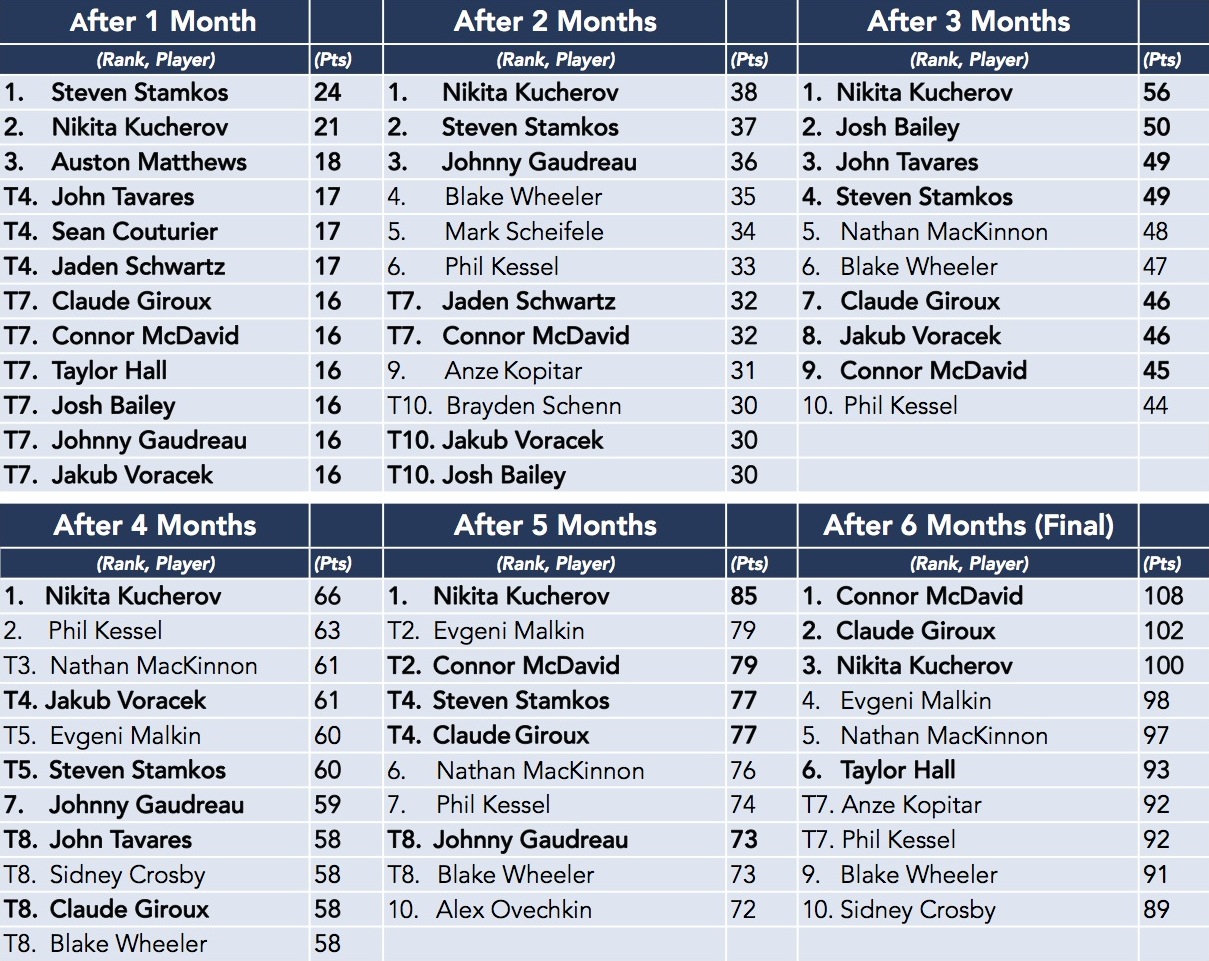
Last year’s race alone is a pretty good illustration of the limited value in focusing on the early-season scoring leaders. Only four of the players who ranked among the top 10 through the opening month managed to stick in the top 10 by the season’s end — and only one of the first month’s top five scorers finished among the end-of-year top 10 at all.
Eventual Art Ross Trophy-winner, Connor McDavid, didn’t crack the top five scorers until the second-last month of the season. The Oilers captain scored at a 1.12 points-per-game clip between opening night and the start of February, before ramping up significantly over the final stretch, posting a 1.64 points-per-game pace from February to the end of the campaign.
Meanwhile, Nikita Kucherov, who seemed the Art Ross favourite all season long, was bypassed late in the season by both McDavid and Claude Giroux, who similarly didn’t crack the top five until five months were already in the books.
2016-17 Top 10 Scorers (Monthly)
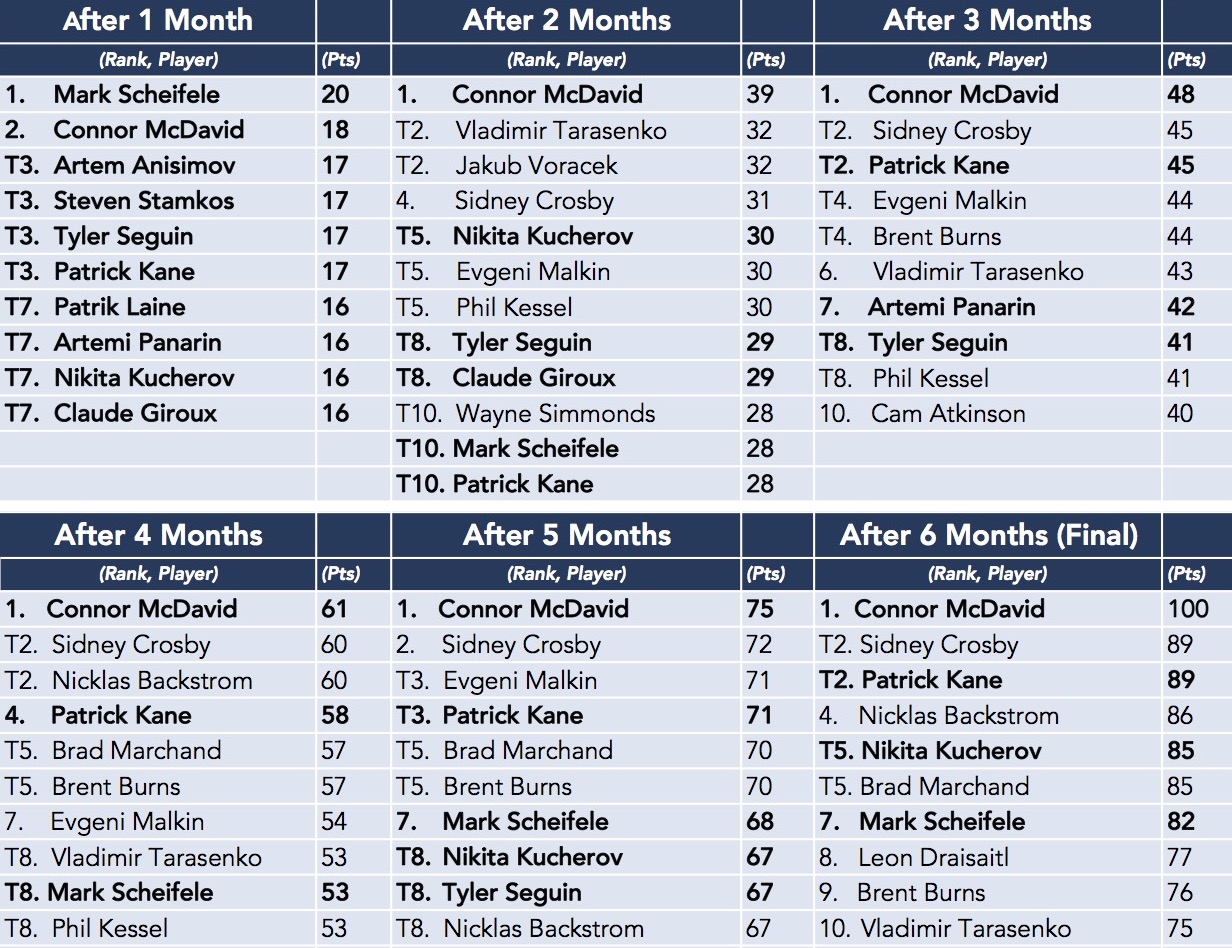
We saw a far different race take shape in 2016-17, McDavid’s first Art Ross ascent. The Oilers captain took hold of the top spot during the second month of the season, overtaking Mark Scheifele after the Jets pivot cooled off, and never relinquishing the No.1 ranking.
Runner-up Sidney Crosby started slow before cracking the top 10 in month No. 2, and then remained among the top two spots from the third month through to the end. Nicklas Backstrom was kept out of the top spots through the first half of the year before climbing within one of the league lead as the second half began — the slick-handed Swede finished fourth in the end, just behind Crosby and Kane at No. 2.
Again, only four of the 10 scorers who led the way in the season’s first month wound up cracking the top 10 by the year’s end. In the middle of the season a number of slow starters picked up the pace and took up residence right below McDavid and Crosby.
2015-16 Top 10 Scorers (Monthly)
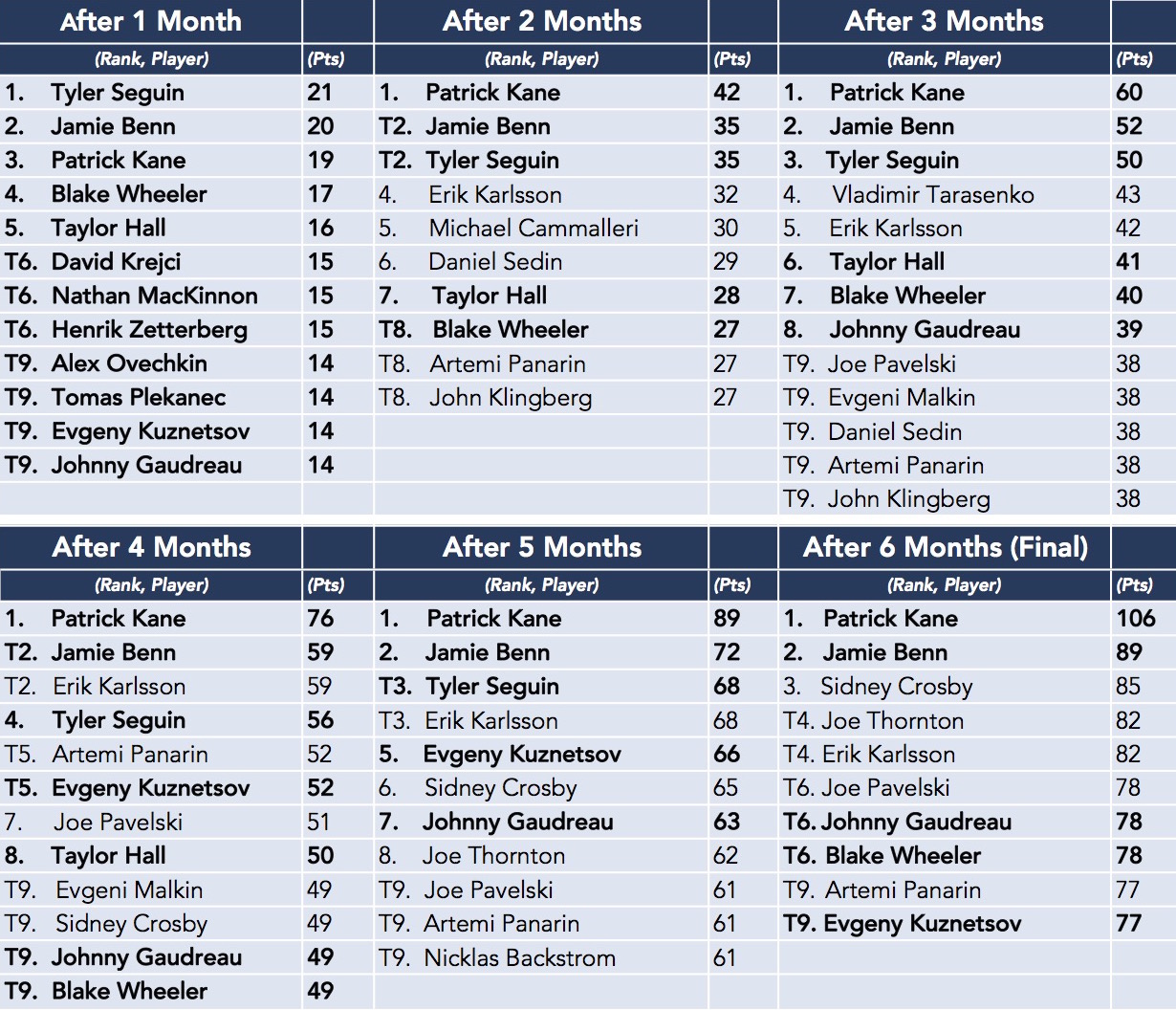
The top of the billing in 2015-16 held for basically the entire campaign, as the duo of Patrick Kane and Jamie Benn stuck in the top three from start to finish and were 1-2 for the final five months. Tyler Seguin could have stuck in the top three all season, too, if not for an injury that cut his season short.
Perhaps the most interesting climber was Crosby, who was buried in the charts below the top 10 for the entire first half of the year, but scaled the ladder rapidly from the fourth month on to eventually pass everyone but Kane and Benn. That timely ascent came as a result of an absurd uptick in scoring pace — Crosby was rolling at just 0.78 points per game before his club fired head coach Mike Johnston and replaced him with Mike Sullivan, but scored at a 1.32 points-per-game clip from the beginning of the new year and lead the league in scoring from that point on.
Yet again, the majority of the names who cracked the top 10 early on in the season faded out by the final months, as only five of the 12 original leaders finished the year in a similar position.
2014-15 Top 10 Scorers (Monthly)
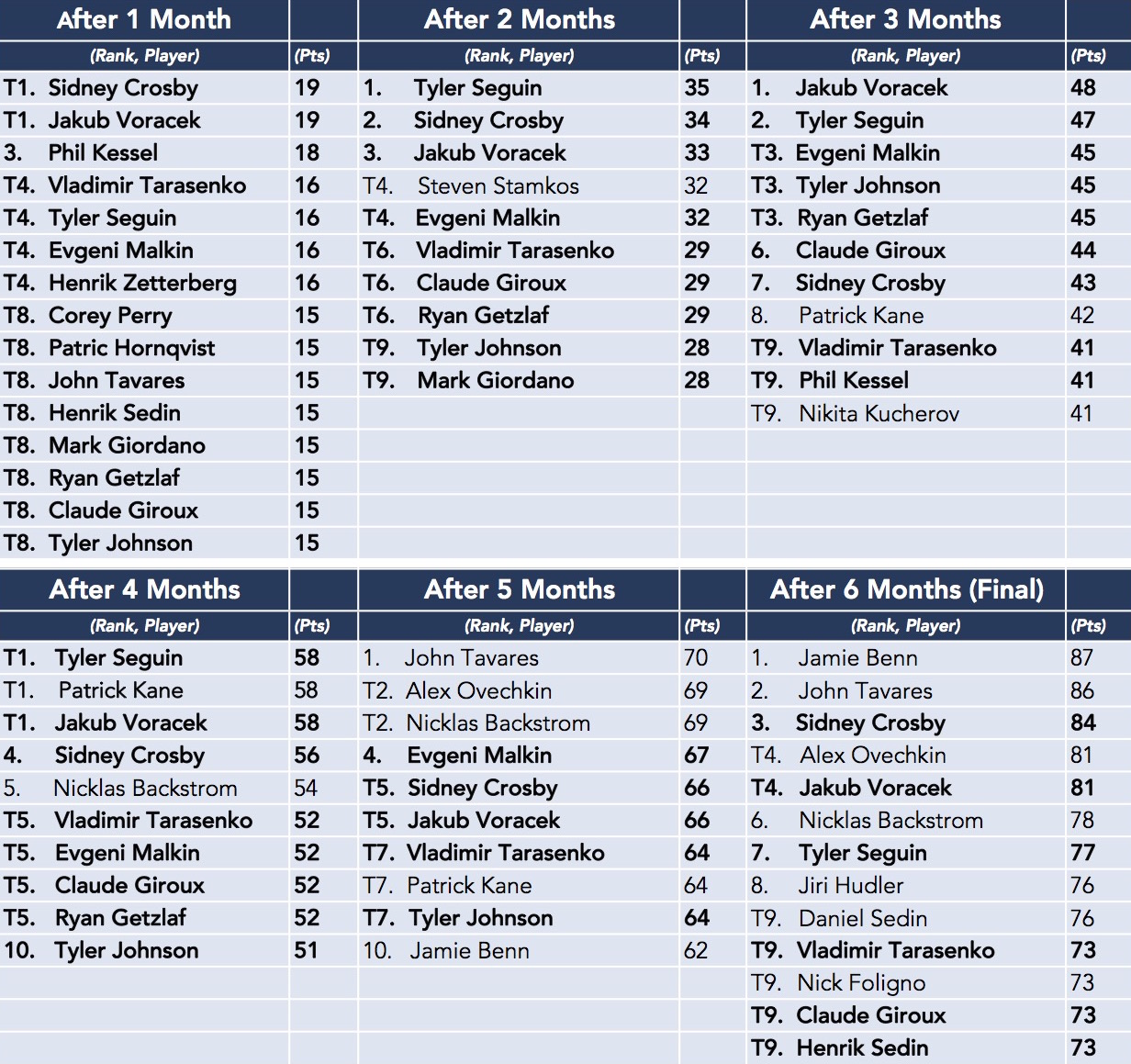
The 2014-15 season may have been the most interesting one among this five-year sample in terms of illustrating just how unpredictable the late stages of the NHL’s scoring race can be.
The first month of the campaign saw 12 players score at a near-identical pace, sitting either level or separated by one point. Much of that same group carried the load for the majority of the season, as the first four months featured top 10s comprised almost exclusively of skaters who began among the opening month’s leaders — not necessarily surprising given how many players squeezed into that early group. But things shifted in the fifth month of the season.
John Tavares and Alex Ovechkin — neither of whom ranked among the top scorers through the first four months — shot to the top of the charts, the former doing so after a stretch of 1.22 points-per-game scoring during January and February. But the most unexpected jump came from Benn, who cracked the list only in the second-last month of the year and then managed to climb all the way to No. 1 over the final month of the season.
When all was said and done, three of the top four scorers by season’s end were players who hadn’t sniffed the top 10 until the final two months of the campaign.
2013-14 Top 10 Scorers (Monthly)
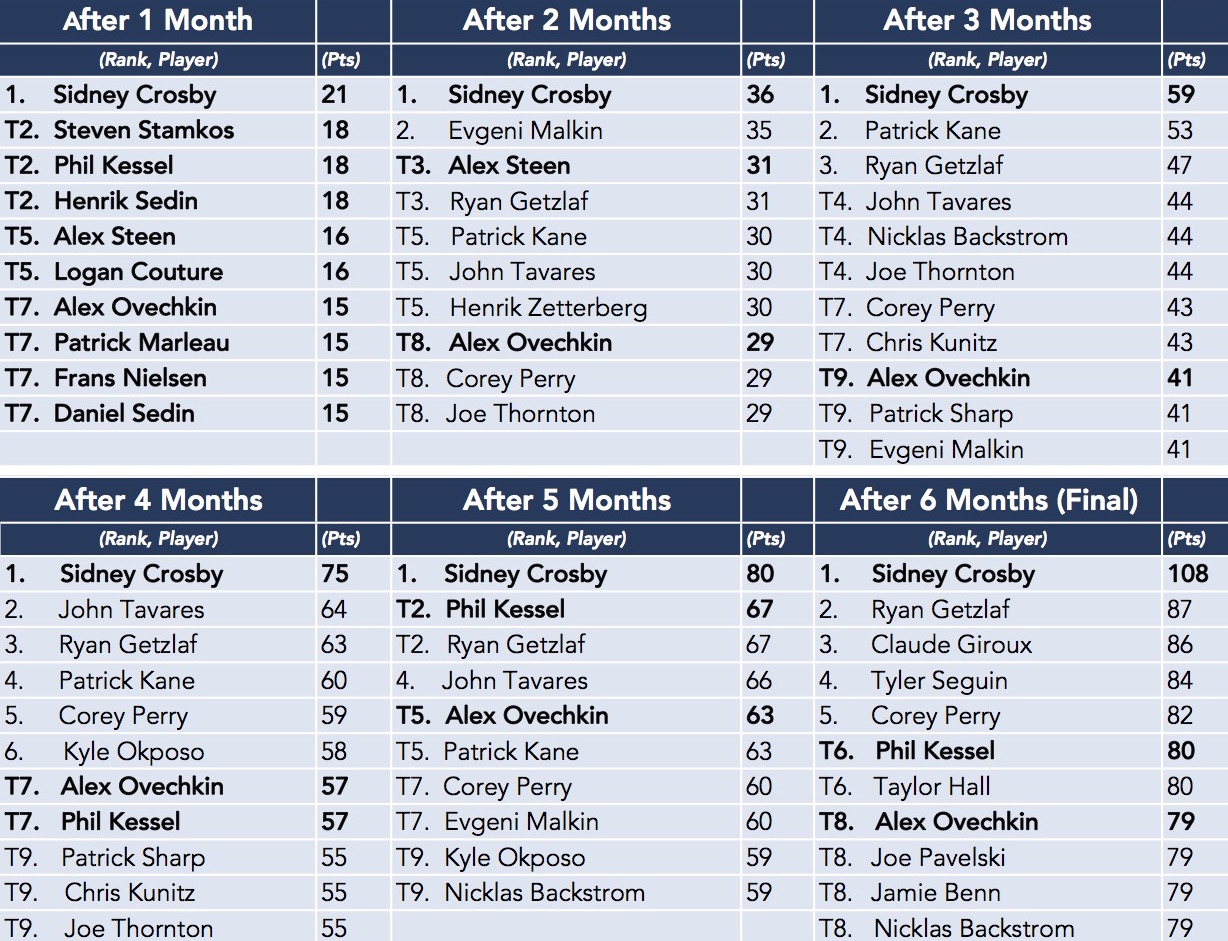
Essentially the opposite of the year that followed it, the 2013-14 campaign saw a number of hot starts tail off by the second month of the season, with just three opening-month top scorers lasting into month No. 2.
Only two of those survivors, Crosby and Ovechkin, continued on from there, before Phil Kessel worked his way back in over the second half of the campaign. Much of the rest of the group that started slow but emerged among the top 10 during the season’s second month held on for the remainder of the season. The biggest unpredictable rise came from Claude Giroux, who was kept off the top of the charts all season until a late scoring binge — 1.32 points per game from March 1 to the end of the year — eventually finished him with the third-most points in the league.
By season’s end, only three of the first month’s top 10 had held on. Crosby, who opened the season in the No. 1 spot, held that crown through to the end.
[snippet id=3816507]
The Art Ross race is a complicated trek, and never as linear as it seems. The NHL in October bears little resemblance to gameplay during the final months, when the impending grind of the post-season and battles to clinch spots saps up space that was given earlier on.
The league’s elite hit their strides at different points in the year, with contextual factors for each specific team affecting when top-end players put together the type of dominant stretches that pull them to the top of the scoring charts. Some do so early, but as seen above, there’s just as good a chance those scoring streaks come mid-way through the year or down the home stretch. Those can easily be enough to pull top-end players into the final top five.
A number of unexpected names may pop into the top 10 early in the year as those processes begin to play out, but looking back through the past half-decade of monthly fluctuations, it’s clear these early rankings mean little when predicting who will walk away with the Art Ross Trophy. The true barometer isn’t who puts together the strongest start and comes out of the gate hot, but who can keep up a consistent pace as the year progresses, and maximize their output when the majority of players tail off during the final third of the year.
[relatedlinks]








